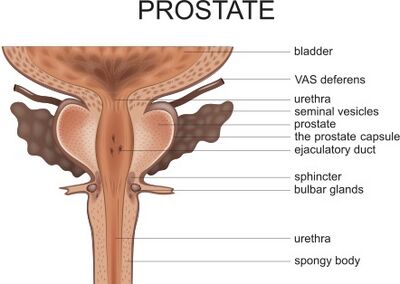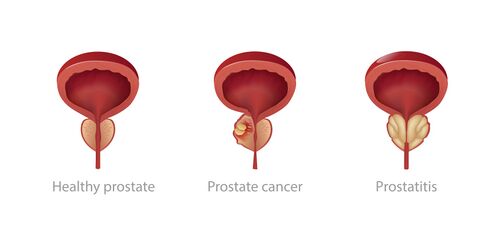Overview of Prostate Cancer
Top Contributors - Stacy Schiurring, Kim Jackson, Lucinda hampton and Jess Bell
Introduction[edit | edit source]
Prostate cancer affects the prostate gland, which is part of the male reproductive system and functions to create seminal fluid.
- In 2020, there were an estimated 1.4 million new cases of prostate cancer and 375,000 prostate cancer related deaths worldwide[1]
- Prostate cancer was the second most frequent cancer and the fifth leading cause of cancer death among men[1]
- It was the most frequently diagnosed cancer in men in over one-half of the countries of the world[1]
- Differences in prostate cancer diagnostic practices are most likely the greatest contributor to the worldwide variation in prostate cancer incidence rates[1]
- The majority of men diagnosed with prostate cancer have a slow growing variation of the disease that is nonthreatening to their natural life expectancy and can be safely monitored without need for medical intervention[2]
- For those men diagnosed with metastatic prostate cancer, only 28% will survive beyond five years of diagnosis[2]
- The prognosis worsens if the cancer has a chance to spread, metastasis rapidly involves the lymphatic system, lungs, bone marrow, liver or adrenal glands[2]
The treatment of prostate cancer is a common entryway into the speciality area of men's health physiotherapy because these patients can be effectively treated without competency in the full scope of men's health skills such as the internal examination and use of real-time ultrasound.[3] Please follow these links to learn more about physiotherapy assessment and treatment of men's health conditions.
Anatomy Review[edit | edit source]
- The prostate is a gland located immediately below the internal urethral sphincter and surrounds the commencement of the urethra. The external urethral sphincter is immediately below the prostate. It is situated in the pelvic cavity: below the lower part of the symphysis pubis, above the superior fascia of the urogenital diaphragm, and in front of the rectum. It can be palpated, especially when enlarged.[4] It is about the size of a walnut.[3]
- The prostate is perforated by both the urethra and the ejaculatory ducts. The ejaculatory ducts open into the prostatic portion of the urethra.[4]
- Arterial supply: internal pudendal, inferior vesical, and middle hemorrhoidal.[4]
- Innervation: receives sympathetic input via the hypogastric nerve and parasympathetic input via the pelvic nerve. The hypogastric and pelvic nerves also provide sensory inputs to the gland.[5]
- The prostate gland is divided into three anatomical lobes: two anterior and one median[2]
- Knowing the anatomy of the prostate is central to the understanding of both benign and malignant prostatic pathologies. This is because the area of the prostate the pathology originates is a defining characteristic of each of the three main prostate diseases. The three main diseases of the prostate are:[2]
- Benign prostate hyperplasia (BPH)
- Prostate cancer
- Chronic prostatitis
- Knowing the anatomy of the prostate is central to the understanding of both benign and malignant prostatic pathologies. This is because the area of the prostate the pathology originates is a defining characteristic of each of the three main prostate diseases. The three main diseases of the prostate are:[2]
Characteristics/Clinical Presentation[edit | edit source]
Early prostate cancer may be asymptomatic, routine screenings of prostate cancer are commonly being done on asymptomatic men.
Clinical Signs and Symptoms:
- Difficulty starting urination
- Weak or interrupted flow of urine
- Frequent urination, especially at night
- Difficulty emptying the bladder completely
- Pain or burning during urination
- Blood in the urine or semen
- Pain in the back, hips, or pelvis that doesn’t go away
- Painful ejaculation or orgasm[3]
It is important to note that these signs and symptoms may also be present with other noncancerous prostate-related disease conditions such as BPH or prostatitis. If a patient presents with the above symptoms, referral to a medical doctor or urologist is urgently recommended for proper diagnosis.
Cancer is one condition that can affect the prostate and cause enlargement of the gland. When the prostate enlarges, it can compress the urethra and cause difficulties with urine flow. An enlarged prostate is not always lead to a diagnosis of prostate cancer, rather that further testing in indicated for proper differential diagnosis.[3]
If a patient reports symptoms of sexual dysfunction, it is important to ask about the timeline of their issues. It is of greater concern if the sexual dysfunction issue involves orgasm and ejaculation, and have occurred within the previous few months. A referral should be made for differential diagnosis.[3]
Tumor Staging[edit | edit source]
- The diagnosis of prostate cancer is established via a biopsy of the prostate gland
- A small piece of the prostate gland is removed and examined under a microscope for cancer cells. If cancer cells are found then a Gleason score will be determined from the biopsy. A Gleason score indicates how likely the cancer is to spread. It ranges from 2–10, the lower the score the less likely it is that cancer will spread
- False-negative results often occur; therefore, multiple biopsies may be done before prostate cancer can be detected and confirmed
Stage I: Cancer cannot be felt during a digital rectal exam, but it may be found during surgery being done for another reason. Cancer has not yet spread to other areas.
Stage II: Cancer can be felt during a digital rectal exam or discovered during a biopsy. Cancer has not yet spread.
Stage III :Cancer has spread to nearby tissue
Stage IV: Cancer has spread to lymph nodes or to other parts of the body
Prostate Cancer Risk Factors[edit | edit source]
While the prevalence of prostate cancer is common, relatively little is known about its etiology.[1] There are several known risk factors that have been shown to indicate an increase in the risk of developing this type of cancer, however many patients with one or more risk factors never get cancer, while others who get cancer may have had few or no known risk factors.
The following are risk factors for prostate cancer according to the American Cancer Society:
- Age: rare in men under 40yo, chance rises rapidly after age 50. About 6 in 10 cases of prostate cancer are found in men older than 65.
- Race/ethnicity: develops more often in African American men and in Caribbean men of African ancestry, less often in Asian American and Hispanic/Latino men than in non-Hispanic whites. The reasons for these racial and ethnic differences are unclear.
- Geography: most common in North America, northwestern Europe, Australia, and on Caribbean islands. It is less common in Asia, Africa, Central America, and South America. The reasons for this are not clear.
- Family history: seems to run in some families, which suggests there may be a genetic factor in some cases. However, most prostate cancers occur in patients without a family history of it.
- Gene changes: several inherited gene mutations seem to raise prostate cancer risk a small percentage.
Factors with less clear effects on prostate cancer risk:
- Diet: the exact role of diet in prostate cancer is unclear. Some studies suggest that men who consume a lot of dairy or calcium (through food or supplements) may have a higher risk of developing prostate cancer.
- Obesity: there may be a weak link between obesity and risk of developing more aggressive prostate cancer. The reasons for this are not clear.
- Smoking: some research has linked smoking to a possible small increased risk of dying from prostate cancer, but further research is indicated.
- Chemical exposures: the National Academy of Medicine considers there to be “limited/suggestive evidence” of a link between Agent Orange exposure and developing prostate cancer.
- Inflammation of the prostate: there is a possible link between prostatitis and an increased risk of developing prostate cancer. This is an area of ongoing research.
- Sexually transmitted infections: there is a possible link between sexually transmitted infections such as gonorrhea or chlamydia and increased risk of prostate cancer.
- Vasectomy: some studies have suggested that there is an increased risk for prostate cancer after undergoing a vasectomy.
Associated Co-morbidities[edit | edit source]
Prostate Cancer Tests and Screenings[edit | edit source]
Although PSA remains the gold-standard biomarker for PCa diagnosis and is one of the most widely used blood-based biomarkers in cancer, it contributes significantly to over-treatment of men with PCa [5]. This is a significant issue, as treatment options for PCa are associated with side effects that can have a profound negative impact on quality of life.[2]
Treatment Options[edit | edit source]
Compare pro's and con's
Side effects/expected PT symptoms
Surgical Interventions[edit | edit source]
Radiation[edit | edit source]
Active Surveillance[edit | edit source]
Resources[edit | edit source]
- bulleted list
- x
or
- numbered list
- x
References[edit | edit source]
- ↑ 1.0 1.1 1.2 1.3 1.4 Sung H, Ferlay J, Siegel RL, Laversanne M, Soerjomataram I, Jemal A, Bray F. Global cancer statistics 2020: GLOBOCAN estimates of incidence and mortality worldwide for 36 cancers in 185 countries. CA: a cancer journal for clinicians. 2021 May;71(3):209-49.
- ↑ 2.0 2.1 2.2 2.3 2.4 2.5 Tonry C, Finn S, Armstrong J, Pennington SR. Clinical proteomics for prostate cancer: understanding prostate cancer pathology and protein biomarkers for improved disease management. Clinical Proteomics. 2020 Dec;17(1):1-31.
- ↑ 3.0 3.1 3.2 3.3 3.4 Roscher, P. Men's Health. Overview of Prostate Cancer. Physioplus. 2022
- ↑ 4.0 4.1 4.2 Gray H. Anatomy of the human body. Philadelphia: Lea & Febiger, 1918; Bartleby. com, 2000.
- ↑ White CW, Xie JH, Ventura S. Age-related changes in the innervation of the prostate gland: implications for prostate cancer initiation and progression. Organogenesis. 2013 Jul 1;9(3):206-15.
- ↑ Centers for Disease Control and Prevention. What Are the Symptoms of Prostate Cancer? Available from: https://www.cdc.gov/cancer/prostate/basic_info/symptoms.htm (accessed 14/04/2022).
- ↑ 7.0 7.1 American Cancer Society. Prostate Cancer Risk Factors. Available from: https://www.cancer.org/cancer/prostate-cancer/causes-risks-prevention/risk-factors.html (accessed 16/04/2022).









